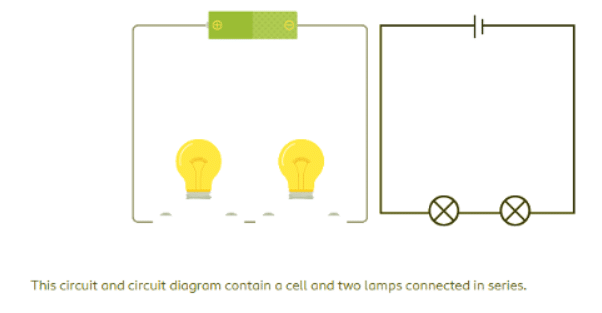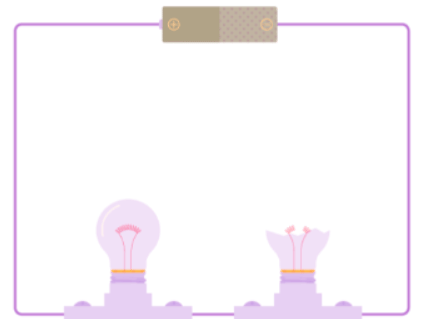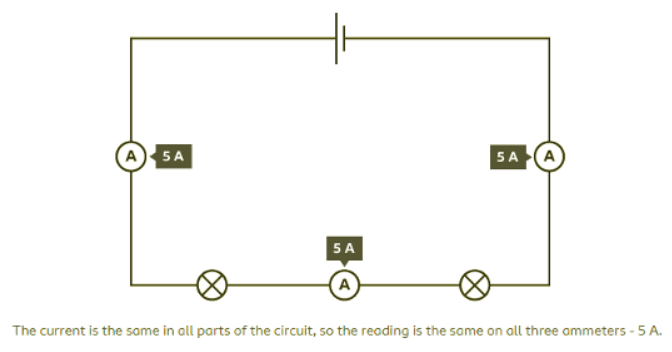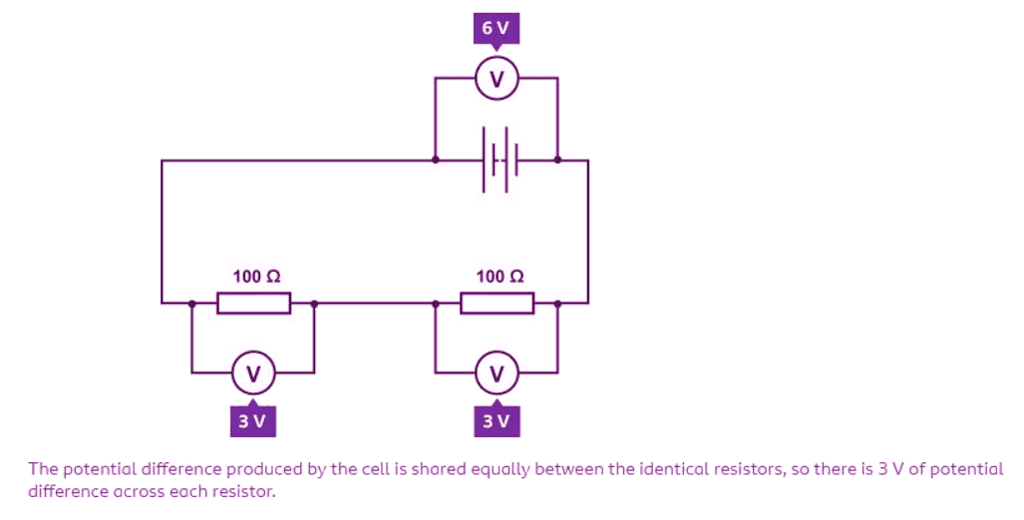Year 7 Exam > Year 7 Notes > Series Circuits
Series Circuits - Year 7 PDF Download
Introduction
- Electrical circuits can be connected in series or parallel.
- In a series circuit, the current is consistent throughout all parts of the circuit.
- Resistance (R) increases when components, such as a lamp, are added in series to the circuit.
- In a series circuit, the potential difference is divided among the components.
Connecting components in series
- When components like a battery, motor, lamp, switch, or wire are connected in series, they form a single loop where each component is placed one after another, similar to episodes in a TV series.
- The components are linked end-to-end, with the final wire closing the circuit, creating a single path for the current (I) to flow. Current, which is the flow of charges, is measured in amps (A).

- In a series circuit, if a lamp breaks or a component is disconnected, the entire circuit is interrupted, causing all components to stop working.
- Current ceases to flow in the circuit because the loop is no longer complete, preventing the current from circulating.
- Switches can be incorporated into a series circuit to control the components, turning them on or off.
- If any switch in a series circuit is open, the current stops flowing, causing all components to stop working.
 If one component in a series circuit breaks, all the components stop working because current stops flowing.
If one component in a series circuit breaks, all the components stop working because current stops flowing.
Current and Resistance in Series Circuits
- Current (I) is the flow of charges measured in amperes (A).
- In a series circuit, current has the same value throughout the circuit.
- Regardless of where the ammeter is placed in a series circuit, it will show the same reading.
- Series circuits involve connecting components in a single loop with only one path for current to flow.

- Example of Current in Series Circuit:
- In a circuit with a cell, two lamps, and three ammeters, all ammeters display the same reading due to the single path for current flow.
Adding Components in Series
- When components are added in series in a circuit, the total resistance increases. Consequently, the flow of current decreases.
- In a circuit with a single lamp, a cell, a switch, and an ammeter, a current of 4 A is observed.
- When two lamps are added to the circuit along with the cell, switch, and ammeter, the total resistance increases. As a result, the current reduces to 2 A. This decrease in current leads to dimmer light emitted by the lamps.

Potential difference in series circuits
- The potential difference generated by a cell or battery is distributed among the components in a series circuit.
- The sum of the potential differences across each component equals the total potential difference of the cell or battery.
- In a circuit with a 6 V battery and two 100 Ω resistors in series, voltmeters connected across the battery and components measure the potential difference.
- Since the resistors are identical, the potential difference across each resistor is 3 V, dividing equally between them.

- If the components in a series circuit have different resistances, the potential difference divides unequally across them.
Question for Series CircuitsTry yourself: What happens to the current in a series circuit when components are added?View Solution
Resistors in Series
- If resistor A component which resists the flow of current. are placed in series in a circuit, the overall resistance (R) increases. This means that it becomes more difficult for current to flow through the circuit.
- When resistors are connected in series, their resistances add up to give the total resistance of the circuit. For example, if you have a 5Ω resistor and a 10Ω resistor connected in series, the total resistance would be 15Ω.
- Series circuits have the same current passing through each component. This implies that the current remains constant throughout the circuit. For instance, if you have a series circuit with a 2A current passing through it, every component in the circuit will also have a 2A current flowing through it.
- One key aspect of resistors in series is that if one resistor fails or is removed, it can interrupt the flow of current through the entire circuit. This is because removing a component from a series circuit creates an open circuit, preventing the flow of electricity.
Resistors in Parallel
- When resistors are connected in parallel in a circuit, the total resistance of the circuit decreases. This is because the current has multiple paths to follow, reducing the overall resistance compared to when the resistors are in series.
- In a parallel circuit, each resistor has the full circuit voltage applied to it. This means that if you have a 12V battery connected to three parallel resistors, each resistor will have 12V across it.
- Parallel circuits have the same voltage across each branch. If you measure the voltage across each resistor in a parallel circuit, you will find that it is the same across all of them. This is because each branch in a parallel circuit is connected across the same voltage source.
- If one resistor fails in a parallel circuit, the other components will continue to operate as they are on separate branches. Unlike in series circuits, where a single component failure can disrupt the entire circuit, parallel circuits offer redundancy in operation.
FAQs on Series Circuits - Year 7
| 1. What are the key points to consider in electric circuits? |  |
Ans. The key points to consider in electric circuits include understanding potential difference, circuit breaks and switches, current and resistance in series circuits, and how components are connected in series.
| 2. How can components be connected in series circuits? |  |
Ans. Components in series circuits are connected one after the other, forming a single pathway for the current to flow through each component in order.
| 3. What is the significance of potential difference in series circuits? |  |
Ans. Potential difference in series circuits is the total energy used by the components in the circuit, and it is shared among all the components based on their resistance.
| 4. What role do circuit breaks and switches play in electric circuits? |  |
Ans. Circuit breaks and switches are used to control the flow of electricity in a circuit. Circuit breaks are designed to automatically interrupt the flow of current in case of an overload or short circuit, while switches allow for manual control of the circuit.
| 5. How does current and resistance affect series circuits? |  |
Ans. Current is the flow of electric charge through a circuit, and resistance is the opposition to this flow. In series circuits, the total resistance is the sum of the individual resistances, and the current is the same throughout the circuit.
Related Searches















